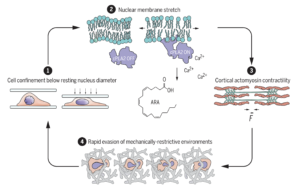 The cells that make up our organs and tissues are capable of responding to changes of cellular density and space in their environment. One of the most relevant examples is represented by cells of the immune system, which can choose the step of least resistance during their migration, through our body, to fight infections. There are many examples like this in our body that occur both in homeostasis and in cancerous and developmental processes.
The cells that make up our organs and tissues are capable of responding to changes of cellular density and space in their environment. One of the most relevant examples is represented by cells of the immune system, which can choose the step of least resistance during their migration, through our body, to fight infections. There are many examples like this in our body that occur both in homeostasis and in cancerous and developmental processes.
However, how these and other cells “measure” their environment and respond accordingly was not fully understood. In a study published today in the journal Science, an international group of researchers from the United Kingdom, Germany, Austria, France, the United States and Spain, led by King’s College London, shows that different cell types can use the cell nucleus – the most rigid and voluminous organelle in the cell – to measure the level of confinement to which they are subjected. Marc Molina, current researcher at IBEC in Barcelona, is co-author of this article, for his contributions to it during the work carried out in the iBCTM laboratory led by Dr. Alexis J. Lomakin, at King’s College London. Another study published in the same journal, with the participation of researchers from the CRG and ICFO, simultaneously demonstrates the same principle.
Contributing to a project this big, seeing how all the pieces fit together and that your work is finally published is an indescribable feeling.
Marc Molina
Using various techniques, ranging from pressing different parts of cells to making them circulate through different diameter channels, the researchers show that the nucleus is capable of producing a cellular response under pressure. In particular, when the cells experience the deformation of their nucleus above a certain level, they respond activating their cytoskeleton generating force to counteract the compression. The role of the nucleus in this process is essential, because in his absence, the cells are unable to make the response. In addition, the mechanical properties of this organelle are the ones that dictates at what confinement regime the mechanism is triggered.
 A human cancer cell goes through a narrow passage. Source: Alexis Lomakin, Cancer Research Center Vienna.
A human cancer cell goes through a narrow passage. Source: Alexis Lomakin, Cancer Research Center Vienna.
These results are of special interests for the cell migration study in both healthy and cancerous tissue. This is because it answers to why different cellular types have greater or lesser susceptibility to different confinement degrees and relates it to the mechanical characteristics of the nucleus. In this way, it is possible to understand how highly migratory cells, as can be the immune system ones, or other metastatic ones, are capable to move more easily and through narrower spaces than other cell types.
This study attributes a previously unknown role to the cellular nucleus and describes a new mechanism by which cells can interact with their environment. According to researchers, the next step will be to find out in detail which proteins in the nucleus are in charge of this process and delve into the stages immediately after the activation of this mechanism.
Reference article: A. J. Lomakin, C. J. Cattin, D. Cuvelier, Z. Alraies, M. Molina, G. P. F. Nader, N. Srivastava, P. J. Saez, J. M. Garcia-Arcos, I.Y. Zhitnyak, A. Bhargava, M. K. Driscoll, E. S.Welf, R. Fiolka, R. J. Petrie, N. S. De Silva, J. M. González-Granado, N. Manel, A. M. Lennon-Duménil, D. J. Müller, M. Piel. The nucleus acts as a ruler tailoring cell responses to spatial constraints. Science, 2020.


 Contributing to a project this big, seeing how all the pieces fit together and that your work is finally published is an indescribable feeling.
Contributing to a project this big, seeing how all the pieces fit together and that your work is finally published is an indescribable feeling.



